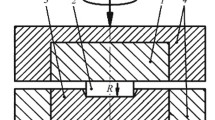Conclusion
When the steels under investigation are subjected to carbonitriding in a hydrogen-free glow-discharge plasma using the dissociation products of ferrocyanides, their wear resistance and impact strength increase as compared with nitriding in ammonium. Steel R0M2F3 has the highest wear resistance and impact strength.
Similar content being viewed by others
Literature cited
M. A. Andreichik and V. Ya. Matyushenko, "Some aspects of the technical absorption of hydrogen by metals and its effect on wear resistance,"Dolg. Trushch. Det. Mashin, No. 1 191–195 (1986).
I. V. Tananaev, G. B. Seifer, Yu. Ya. Kharitonov, et al.Chemistry of Ferrocyanides [in Russian], Nauka, Moscow (1971).
Additional information
I. P. Bardin Central Scientific-Research Institute of Ferrous Metallurgy. Kursk Polytechnic Institute. Translated from Metallovedenie i Termicheskaya Obrabotka Metallov, No. 6, pp. 13–15, June, 1992.
Rights and permissions
About this article
Cite this article
Shcherbedinskii, G.V., Zhelanova, L.A., Zemskii, S.V. et al. Structure and properties of high-speed steels after ionic carbonitriding in a hydrogen-free medium. Met Sci Heat Treat 34, 375–378 (1992). https://doi.org/10.1007/BF00769744
Issue Date:
DOI: https://doi.org/10.1007/BF00769744




